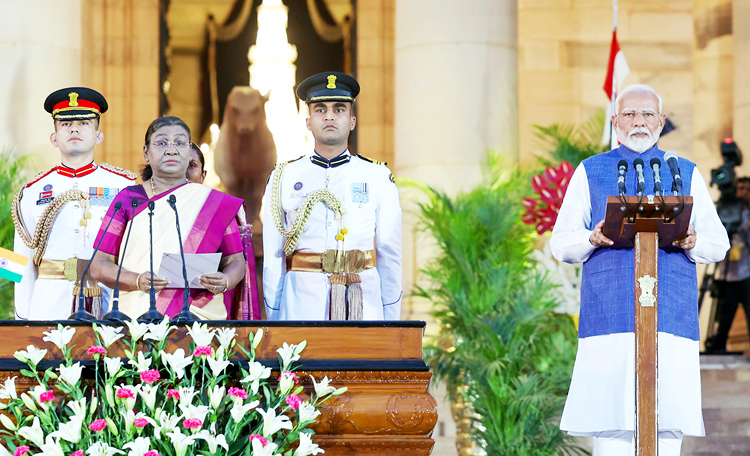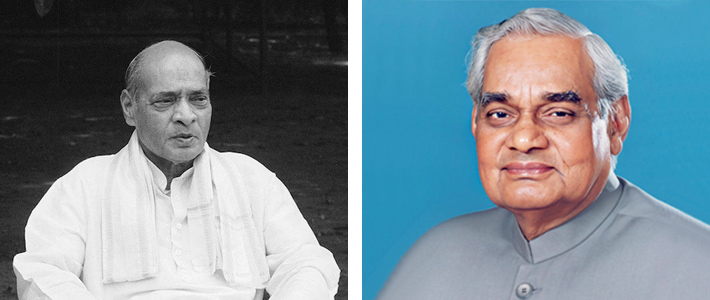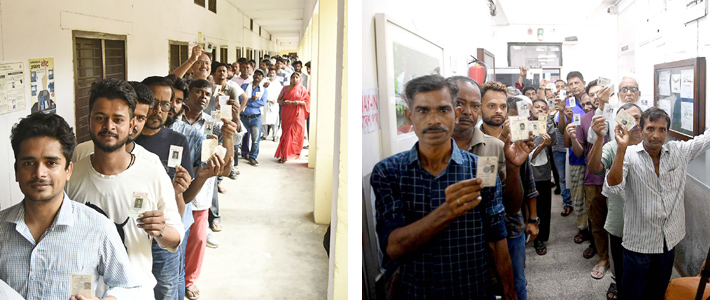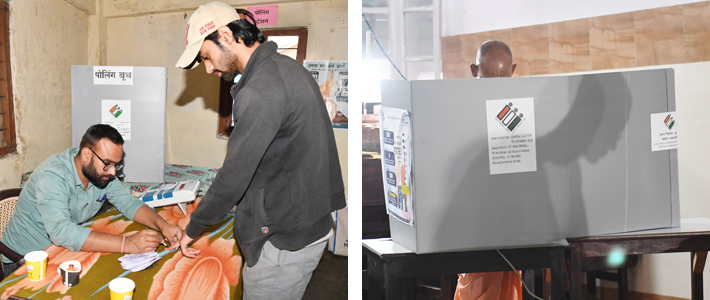INDIAN ARMED FORCES CHIEFS ON OUR RELENTLESS AND FOCUSED PUBLISHING EFFORTS

The insightful articles, inspiring narrations and analytical perspectives presented by the Editorial Team, establish an alluring connect with the reader. My compliments and best wishes to SP Guide Publications.

"Over the past 60 years, the growth of SP Guide Publications has mirrored the rising stature of Indian Navy. Its well-researched and informative magazines on Defence and Aerospace sector have served to shape an educated opinion of our military personnel, policy makers and the public alike. I wish SP's Publication team continued success, fair winds and following seas in all future endeavour!"

Since, its inception in 1964, SP Guide Publications has consistently demonstrated commitment to high-quality journalism in the aerospace and defence sectors, earning a well-deserved reputation as Asia's largest media house in this domain. I wish SP Guide Publications continued success in its pursuit of excellence.
India Votes for Vikas
India's economy has grown remarkably since 1991, transforming from $266 billion to $4.15 trillion, surpassing countries like France and the UK, and becoming the 3rd largest economy in PPP terms
 |
The Author is former Chief of Staff of a frontline Corps in the North East and a former helicopter pilot. He earlier headed the China & neighbourhood desk at the Defence Intelligence Agency. He retired in July 2020 and held the appointment of Addl DG Information Systems at Army HQ. |

As the general elections in India were drawing to a close, news that the Reserve Bank of India (RBI) has moved approximately 100 tonnes (1 lakh kilograms) of gold from the UK to its vaults in India brought cheers.
The 1991 Crisis
This was the first time since 1991 that India had undertaken such a large-scale transfer of gold reserves. The shipment is full of symbolism. Those aware of our state of the economy in 1991 will recollect with trepidation that in January that year, India had less than $1 billion forex reserves, barely enough to meet import requirements for three weeks. So 20 tonnes of gold were pledged to UBS, Switzerland, raising $200 million by the end of May 1991. After the elections in July 1991, the RBI pledged another 46.91 tonnes of gold to the Bank of England and Bank of Japan to raise $400 million.

It has been a remarkable journey for the Indian economy since then. A series of economic and structural reforms by the Narasimha Rao government saw a swing around of investor confidence. The pace of reforms gained further momentum under the six years of Vajpayee government till 2004. However, the pace of growth has been phenomenal since 2014. In a sense, the growth story of the past three decades and half can be more or less fitted into three somewhat distinct but not watertight time spans, 1991-2004, 2004-2014 and 2014-till date.
The Reserve Bank of India (RBI) recently moved approximately 100 tonnes of gold from the UK to its vaults in India, marking the first large-scale transfer of gold reserves since 1991.
Economic Reforms and Transformation
Since the story begins with the return of gold, let us map the journey since 1991 with some cold statistics. In 1991, India's economy at $266 billion was even smaller than that of cities like Paris ($360 billion) or London ($270 billion). Today, at $4.15 trillion, it has surpassed France ($3.1 trillion) and the UK ($3.5 trillion). Specifically, it jumped five places in global ranking between 2014-2024, from being the 10th largest to the 5th largest, surpassing Canada, Russia, Italy, France and the UK. 50 per cent of India's population is below the age of 25. A massive infrastructure pipeline project, at a whopping $1.9 trillion, is nearing completion by 2025 as are eye-popping projects like Bharatmala ($140 billion), Sagarmala ($130 billion), Delhi-Mumbai Industrial Corridor ($100 billion), 100 smart cities at estimated cost of $100 billion etc. India is on course to surpass Germany and Japan to become the 3rd largest economy by 2027. In fact, it is already the 3rd largest in PPP terms at $14.5 trillion.
India has become the 2nd most attractive manufacturing destination globally, with industrial output expected to reach $3 trillion by 2030, bolstered by initiatives like productivity linked incentive (PLI) schemes and a young, well-trained workforce.
With sustained focus like productivity linked incentive (PLI) schemes, and a low-cost well-trained young workforce, India has overtaken US to become the 2nd most attractive manufacturing destination behind China with an industrial output of more than $900 billion which is expected to zoom to $3 trillion by 2030. In 2014, the country had only about 400 startups, today it boasts more than 90,000. India is the fastest growing major economy of the world clocking 8.2 per cent in 2023-24, the fastest growing real-estate market and stock market, fastest growing startup ecosystem and a military and space powerhouse. The Sensex, meanwhile has risen from 1,000 in 1991 to beyond 73,000 today and the forex kitty swelled from less than $1 billion to nearly $650 billion.
Economic Growth vs Inequality
That said, the growth story has many warts. Millions have been left behind, unable to participate in this extraordinary developmental journey. India has become especially unequal between 2014 and 2024, with top 1 per cent garnering 22 per cent of all income and owning 40 per cent of all wealth. Some have used this data to scream during the just concluded general elections that this is a government working only for the rich industrialists. An Adani-Ambani slur was one of the most widely used campaign slogan. How far is it true?
Despite economic growth, India faces significant inequality, with the top 1 per cent owning 40 per cent of all wealth, though the Gini coefficient has shown marginal improvement, dropping to 39 in 2022-23.
Some statistics first. The Gini coefficient, which measures inequality, ranged between 40 and 46 between 1967-68 and 2013-14. But for a six-years Vajpayee government and another few years of unstable coalition governments that saw four different Prime Ministers, for the remainder nearly 40 years of this period, India was ruled by the Congress party. The Gini coefficient was 39 in 2022-23, just marginally better but an improvement all the same. So the pro-rich tag being ascribed to the ruling party doesn't hold much water. But admittedly the inequality is very high and worrying.


However, conclusively failed ideas like forceful redistribution after caste and wealth census, imposition of inheritance tax and ultra-high taxes on the rich are definitely dangerous and can completely derail the growth story of India. Very high taxes reaching almost 97.75 per cent in the early seventies sank the economy and led to massive tax evasion and creation of black money, very large sums fleeing the country into Swiss bank accounts and tax havens like British Virgin Islands, Bahamas and St Kitts.
The successful implementation of the Direct Benefit Transfer (DBT) system, leveraging the JAM trinity (Jan Dhan, Aadhar, Mobile), has drastically reduced subsidy leakages, ensuring that government aid reaches the intended beneficiaries directly.
By seventies, the growth story petered out as corruption and nepotism ruled the roost. This ultimately led us to 1991 when we had to pledge gold abroad. Another blip was the 2004-2014 period which was a lost decade. The gross NPAs of PSU banks increased by almost four times from March 2010 (₹59,972 crore) to March 2014 (₹2,04,249 crore) while the UPA government was winking. PSUs like Air India were left bleeding.
Recent Developments and Future Focus
From those dire states, the turn-around has been miraculous. Air India, in the private hands of the TATA group is on course to massive growth in fleet, routes and profits. The PSU banks have consolidated and the NPAs managed. In the 1980s, then Prime Minister Rajiv Gandhi had said that out of every rupee sent by the Centre government, only 15 paise reaches the poor. The DBT has changed that. With the help of the JAM (Jan Dhan + Aadhar + Mobile) trinity, the government achieved the feat of transferring subsidies directly to the people through their bank accounts without leakages.
Inclusive growth with equality in opportunity for all citizens can only be achieved through quality and affordable education, healthcare and improved infrastructure. The first two remain India's weakness. Now that the long winding and bitterly fought elections are done and dusted, it is clear that the average citizen has reposed faith in India's growth trajectory despite the resurgence of divisive caste and sectarian issues that were fanned internally as well as by powerful external vested interests. Putting these behind, the incoming NDA 3.0 government will do well to focus on education and healthcare in order to reap our demographic dividend.





